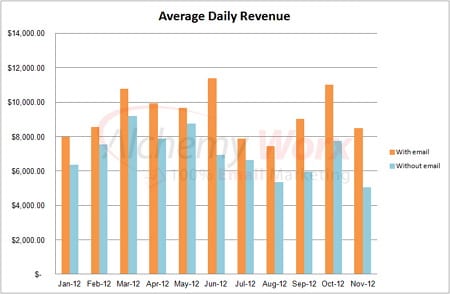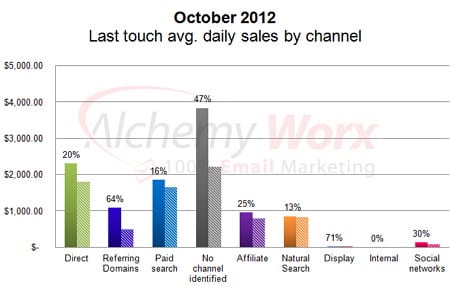Examples of the many ways email marketing influences sale in addition to clickthrough
Email Marketing is already highly valued by a diverse range of B2B and B2C companies because of the excellent ROI it provides.
eCommerce brands are the biggest users of email, in no small part because the tracking makes the business case for email crystal clear.
Social media too puts huge value on the power of email. Facebook is joint third biggest sender of email worldwide. Whilst ExactTarget is the biggest ESP by sent volume, Facebook sends more email than all their clients put together (source Senderbase top senders)
Even so, could it be that email is undervalued, even by many big brands?
More often than not the value of email is determined by conversion resulting from an email click.
How about when there is no click on an email? Does it mean the email had no value?
It would be strange to consider it having no value, almost like saying that because a TV or Print advert generates no click it had no value...
It’s just harder to measure and understand the value when there is no click. It doesn’t mean the value wasn’t there.
One of my clients sees a high portion of their search traffic on their brand name. No, it’s not a big well known brand and they don’t run branding advertising. The stats make clear that at least some of the searches are caused by email.
So what do people really do after seeing an email besides clicking?
- Search for the brand
- Search for the products promoted
- Use a bookmark to access the brands website
- Visit the brands bricks and mortar shop
- Talk about the brand in social media
- Keep the email to click later
The following charts illustrate the value of email beyond clicking is significant and the direct conversion value of email undervalues the channel.
This first chart shows analysis of daily revenue from a site over nine months, giving revenue, excluding that directly attributed to email, on the days when email is sent versus the days when it isn’t. The orange bars that are days with email sent are consistently and significantly higher than the days without email. In fact on average over 20% higher revenue.

The next chart drills into a month of sales data to break out revenue by channel based on last touch attribution and shows how email adds to all other channels. For each channel there are pair of bars. The taller left bar is the channel revenue on the days with email and the smaller right bar of each pair is on a day without email.

For example, revenue from Direct traffic is 20% higher on the days when email is sent to those without.
Given email doesn’t need a click to deliver revenue it’s surprising that there still isn’t more email being used by High Street stores to drive footfall.
Imagine the impact it would have with the coming Christmas season to be able to reach to previous shoppers through the inbox and let them know what’s going on in store.
And for those that haven’t yet built their email database Christmas represents the chance to kick start this. Offline email address data capture methods that are known to work include:
- Free wifi - Provide your email address in return for in-store wifi
- SMS-2-subscribe - Enter a competition or get discount by texting your email address
- Electronic receipt - Provide your email address to have your receipt and guarantee emailed to you
Whilst revenue is the big focus at Christmas, make sure you are also using all opportunities to capture email addresses too, they are the gift that keeps on giving.








